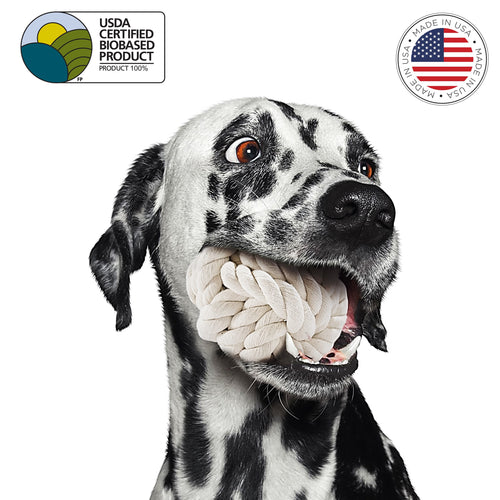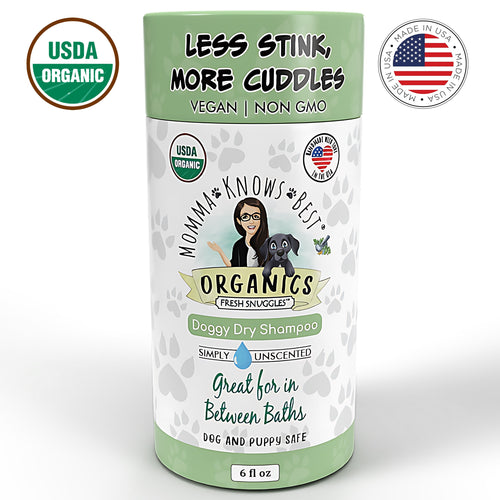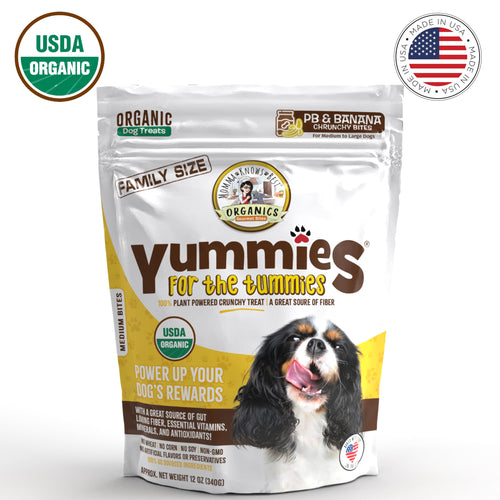Your Cart is Empty
Free 2-5 day delivery | No minimum purchase required
Free 2-5 day delivery | No minimum purchase required
Shop
Learn
Dog Spay Surgery: What Symptoms Can You Expect After?
 by K Marie Alto Updated
10 min read
by K Marie Alto Updated
10 min read

Any surgery carries risk, no matter how routine it is. Whether it's infection, lethargy, changes in hormones, or unexpected complications, it's important to keep an eye on everything and make sure it all heals properly. This applies just as much to people as it does to our furry friends.
Perhaps the single most routine surgery in the veterinary field is that of the spay/neuter. Most people are aware that these surgeries are done and why, but not necessarily what they do, how, or what needs to be done after the surgery itself. I wanted to take a moment today to talk about it!
Table of Contents
- What is Involved in a Spay or Neuter Surgery?
- What Are Common Symptoms After a Spay or Neuter Surgery?
- How Long Does Recovery After Spay or Neuter Surgery Take?
- What Do You Need to Do to Care for Your Dog After a Spay or Neuter Surgery?
- What Symptoms Should You Watch for After a Spay or Neuter Surgery?
- Dog Spay Surgery FAQ
What is Involved in a Spay or Neuter Surgery?
Spaying and neutering are surgical procedures, which means they are invasive and require anesthesia, monitoring, and potentially IV fluids and other care.
The surgery is a lot less invasive for male dogs than for females due to the anatomy involved, but either way, it includes an incision in the flesh of the dog's underbelly, ligation of the blood vessels leading to the relevant reproductive organ, and the removal of that organ.
In male dogs, it's the testicles, while in female dogs, it's usually both the ovaries and the uterus, though in rare cases, it can be just the ovaries.
If you're interested in a closer look, this article covers neutering a male dog, and this one covers spaying a female dog. Fair warning: the neutering article includes pictures, so skip it if you're squeamish.

The key point to take away here is that both surgeries involve incisions of the skin and cutting away organs inside.
No matter how well-practiced the vet, these can always be potentially dangerous due to infection, failed ligations, or other problems.
Your job is to keep an eye on your beloved canine companion to make sure nothing goes wrong and that they heal normally.
What Are Common Symptoms After a Spay or Neuter Surgery?
Surgical recovery is a lengthy process, though your dog probably won't show it as much as you expect them to.
In the first 24 hours after the surgery, your pup will be recovering from being under anesthesia. They'll be groggy and nauseous and may have other symptoms, such as:
-
Glassy-eyed looks
-
Sleepiness
-
Wobbly movement
-
Excessive vocalization
-
Shivering
-
Irritability
All of these are normal. They're shaking off medication and dealing with both an unpleasant sensation, a bunch of disorientation, and a general feeling of not being entirely normal.
They don't know what's going on, and they don't have the language to understand if you explain, so they can only do what they feel they can do: whine about it, usually.
Because of their nausea, your dog is probably not going to want to eat very much. One of the main risks here is dehydration, so make sure to encourage your pup to drink. Offer food in small amounts, but be prepared if they can't keep it down.

After the first day or two, your pet will largely recover mentally, but they are still healing from the surgery. This is the most dangerous time for three main concerns.
The first is infection. While many procedures are in place to make sure your pet is as clean and sterile as possible during the surgery, there's always the risk of infection with any surgery, no matter how thorough the procedures. Keeping an eye out for the signs of infection is your most important job.
The second is reopening the incision. A small amount of bleeding on the first day is normal, but after that, it should remain closed, though it can be red and a little swollen.
If your pet does something that reopens the incision, you'll need to talk to your vet to get it closed back up. Fortunately, these aren't big incisions, so it's not a huge emergency if they reopen.
The third is internal bleeding. Part of the surgery is tying off the blood vessels that feed the organs being removed. There's always a risk, however small, of these not remaining properly tied off and causing internal bleeding. This is one of the biggest emergencies that will need immediate attention.
How Long Does Recovery After Spay or Neuter Surgery Take?
In general, dogs take around 10-14 days to fully recover from a spay or neuter surgery. The first day is the worst, and each day after will be better.
Some dogs take a little longer to recover, which can depend on their age, their size, and if there were any complications with the surgery itself or with their recovery process.

Many dogs will feel like they've recovered earlier, but they aren't great at judging the state of their healing internally, so your job is to keep them relatively calm and still so they don't hurt themselves in their excitement to get back to normal.
What Do You Need to Do to Care for Your Dog After a Spay or Neuter Surgery?
Caring for a dog after a spay surgery is fairly simple, but if it's your first time, it can be a little nerve-wracking. Just remember that millions of pet parents do it every year, and most of them don't have issues, so you'll probably be fine, too.
When you first bring your dog home, let them rest in a quiet, safe place. If you have other pets, kids, or anything stressful in your house, find a place your dog can stay away from them and let them recover there.
Check on your dog frequently for the first 24 hours to make sure they're fine. Complications can happen quite quickly, so you want to keep an eye on them or even stay with them while they rest and shake off the anesthesia.
Give them small amounts of food and water later in the evening. Their appetite won't return to normal for probably about two days, but you want to try to keep them hydrated and fed. Just be prepared for the risk of vomit if they can't keep it down.

Encourage frequent movement. Statistics show that if your dog spends most of the first day sleeping or resting, their recovery is probably going to take longer. You want them up and moving, even if it's just a walk across the room.
At the same time, discourage exercise and play. Jumping, running, and excessive playing risk reopening the incision or the ligations and can cause complications.
Keep the surgical site dry. No swimming, no bathing, no playing in the rain or the snow.
Keep checking the incision. A little redness and swelling are normal, but if it bleeds, reopens, leaks a strange fluid, looks bruised, or is otherwise unnatural, contact your vet.
What Symptoms Should You Watch for After a Spay or Neuter Surgery?
You can generally categorize issues post-surgery as normal, needing attention, or emergency. Let's go through each category.
Normal issues after a surgery.
Normal issues are things you may or may not see, but if you do, they aren't something to worry about. If they stick around or get worse, then they escalate into the next tier of severity, and you'll want to talk to your vet about them.
To be clear, you can call your vet about anything you aren't sure about. They're generally pretty happy to help, even if they are overworked – they love your dog almost as much as you do – and they won't be mad about a nervous call. Just don't necessarily rush your pup into the emergency vet for something that isn't a problem.

So what's on the list?
-
A small amount of blood or bloody discharge from the incision site on the first day after the surgery. Small things like a minor red stain on their bed where they were lying are pretty normal. If it's bad, there will be more volume, or it won't go away even after days.
-
A bit of redness or swelling, or even bruising around the surgical site. An incision is, after all, cutting through the skin. Think of it like when you get a cut yourself; it will be red and irritated because it's damage to the skin.
-
Your dog whining and crying about their situation. Some dogs are way more dramatic than others in their discomfort, but most just won't know what's going on. They'll be disoriented, uncomfortable, and probably in a little pain, and they'll be vocal about it.
-
Not doing their business on schedule. Potty training is important, so this can feel bad, but anesthesia basically halts the digestive process, and your dog probably won't go back to normal for at least a day.
If any of these happen for a day or two, don't worry, and just keep an eye on it. They should go away on their own.
Issues that need some attention.
Now, let's talk about the issues that will require attention but might not need an emergency trip.

These issues include:
-
Significant swelling of the incision. This might be a sign of infection or could require medication to help manage.
-
Colored discharge from the incision. This is generally a sign of some kind of infection and will require medication and maybe cleaning.
-
Pale gums. This can be a sign of internal bleeding or an infection and is worth getting looked at.
-
Long-term lack of appetite. If your dog refuses to eat or drink even after a day or two after the surgery, something might be wrong, and they'll need attention.
-
Intermittent vomiting. Same deal here; it means something is wrong but not immediately life-threatening.
If your dog is experiencing any of these, you'll want to call your vet and talk to them about it. They might be able to do a quick video visit and give you a prescription or advice to try to care for the issue, or they might want you to bring your dog in to be looked at. Follow their advice.
Issues for the emergency vet.
Now, let's talk about the true emergencies. If you see any of these, you'll want to bring your pup to the nearest emergency clinic.

These issues might require another surgery to correct or could be a sign of something dangerous occurring:
-
Consistent blood from the surgical site. This can indicate a failed ligation that will need to be redone.
-
Consistent vomiting that doesn't go away. This can indicate a number of issues that need to be checked out.
-
Difficulty breathing. This is another potentially serious complication that needs immediate attention.
-
Inability to stand or not waking up. Terrifying!
These are your true emergencies, so get going ASAP if you see them.
Dog Spay Surgery FAQ
Now, let's wrap things up with a couple of other questions you might have.
Do you need to keep the incision clean?
Follow your vet's instructions.

Generally, you only need to wipe off discharge if it happens, but otherwise, it's better to leave it alone.
What kind of cone should you put on your dog?
Cones aren't generally recommended these days; instead, a more flexible e-collar is the way to go.

If your dog doesn't seem interested in licking or scratching at their incision, they don't need a collar or cone. If they can't seem to leave it alone, you need to protect the incision from their picking at it, so use the collar.
What if your dog doesn't tolerate a cone?
There are a few other options. One of the most common is a onesie, which can protect the site of the incision while being harder to work around and more comfortable for your pup.
You can also try something like boxer shorts – the fly is for the tail – though with both options, you still need to remove or alter them for potty time.

When all is said and done, you should be in a good position both to have a safe and healthy dog and to go through the whole process again with another dog in the future.
Remember, there are no stupid questions, and you shouldn't feel bad about being concerned. We all have to learn somewhere!
If you have any non-medically-related questions, I'd be more than happy to help out however I can! Just leave a comment down below, and I'll get back to you as soon as possible!
Pure, Safe, and American-Made Dog Supplies – Because Your Dog Deserves the Best
At toe beans, we believe that every dog deserves the cleanest and safest products available. From nutritious treats to grooming supplies, all of our dog supplies are made to protect your dog’s health and enhance their happiness and longevity.
Try our USDA Organic Yummies for the Tummies dog treats, for a guilt-free way to reward your pup with organic, chemical-free yummy snacks. For a shiny and healthy coat try our USDA organic dog shampoos and dog brushes.
Our USDA Biobased certified synthetic-free dog toys are perfect for keeping your dog entertained without exposure to harmful substances. And, for a touch of sophistication and timeless style, explore our US-made leather dog collars and leashes, made with the finest chrome and heavy metal free, veg-tanned Spanish leather; designed for long-lasting comfort and performance. Did you know our dog collars and leashes come with a lifetime warranty?
Every product in our catalog is made using only raw materials certified for sustainability, safety, and non-toxicity by the world’s most trusted organizations such as the USDA, Oeko-Tex®, GOTS®, and FSC® among others.
Setting a New Standard in Dog Supplies with Radical Transparency and Unmatched Safety
Do you know where the ingredients and raw materials in your dog supplies come from? Or, whether they are made by forced labor overseas?
Sadly, most pet brands rely on overseas supply chains, often linked to toxins, harmful chemicals, and forced labor. At toe beans, we do things differently—98% of our products are made in-house or by small-batch U.S. artisans, ensuring total quality control.
Our materials meet strict sustainability and safety standards, certified by The USDA, Oeko-Tex®, GOTS®, and FSC® amongst others.
Ready to provide your dog with the cleanest dog wellness supplies? Shop our dog supplies collection today and experience the toe beans difference!
K Marie Alto
K. Marie is an animal lover, wife, kitty mom, dog auntie, writer, and co-founder of Toe Beans, a proud American family-owned online boutique pet supplies store focused on the improvement of the life of furry family members via pet parent education, better products, and advocacy. She has over 20 years of experience as a pet momma. She loves sharing her personal journey and experience as a pet parent via her blog and Facebook page where she currently has more than 50K followers (@furrytoebeans) and counting :-). Read more
Leave a comment
Comments will be approved before showing up.
Also in Pet Parents Blog by Toe Beans

Techniques To Stop Your Cat from Begging While Eating
by K Marie Alto April 10, 2025 10 min read
Learn how to manage your cat's begging behavior during meal times with effective techniques that enhance comfort and ensure their safety, as well as yours.

The Truth Behind Zeus, The World’s Largest Great Dane
by K Marie Alto April 03, 2025 10 min read
Learn about Zeus, a gentle giant and therapy dog who holds the record as the world’s tallest Great Dane, showcasing his lovable nature and impressive stature.

Bengal Cat Guide: History, Health, and Personality Traits
by K Marie Alto March 27, 2025 9 min read 2 Comments
Learn about the Bengal cat with our guide, covering their history, health, and personality traits to help you decide if this striking breed is right for you.
Related Products

Dog Rope Toy | The Bio-Ball
$15.99

Dry Dog Shampoo | USDA Organic | Made in the USA
$19.95

Organic Dog Treats | PB & Banana | Family Size | 12 oz
$12.99
Recent Articles
- Techniques To Stop Your Cat from Begging While Eating April 10, 2025
- The Truth Behind Zeus, The World’s Largest Great Dane April 03, 2025
- Bengal Cat Guide: History, Health, and Personality Traits March 27, 2025
- How Can You Stop Your Dog from Licking Their Paws? March 20, 2025
- Why You Should Invest in Automatic Pet Water Fountains March 13, 2025
- Guide: The Ultimate List of Fruits That Your Dog Can't Eat March 06, 2025
- Is Your Cat in Heat? The Signs and What You Should Know February 27, 2025
- Dog Spay Surgery: What Symptoms Can You Expect After? February 19, 2025
- DIY Tips for Making Healthy Homemade Cat Food Recipes February 13, 2025
- 10 Tips for Training Blind Dogs from Expert Trainers February 06, 2025
